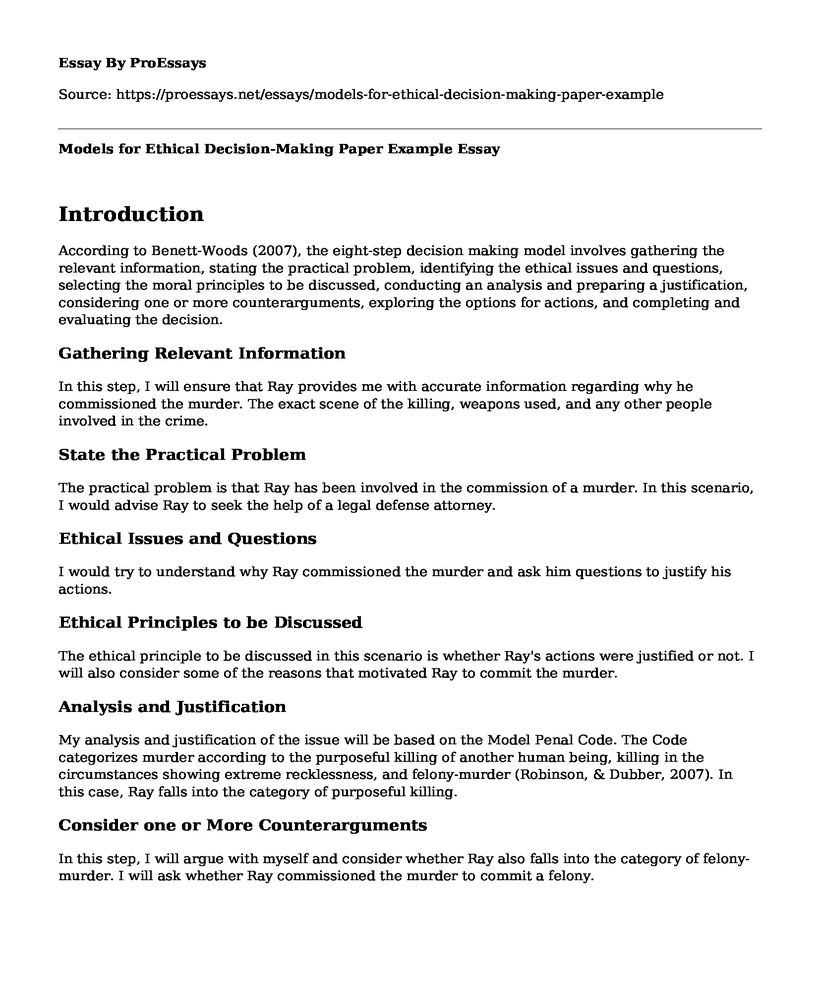Introduction
According to Benett-Woods (2007), the eight-step decision making model involves gathering the relevant information, stating the practical problem, identifying the ethical issues and questions, selecting the moral principles to be discussed, conducting an analysis and preparing a justification, considering one or more counterarguments, exploring the options for actions, and completing and evaluating the decision.
Gathering Relevant Information
In this step, I will ensure that Ray provides me with accurate information regarding why he commissioned the murder. The exact scene of the killing, weapons used, and any other people involved in the crime.
State the Practical Problem
The practical problem is that Ray has been involved in the commission of a murder. In this scenario, I would advise Ray to seek the help of a legal defense attorney.
Ethical Issues and Questions
I would try to understand why Ray commissioned the murder and ask him questions to justify his actions.
Ethical Principles to be Discussed
The ethical principle to be discussed in this scenario is whether Ray's actions were justified or not. I will also consider some of the reasons that motivated Ray to commit the murder.
Analysis and Justification
My analysis and justification of the issue will be based on the Model Penal Code. The Code categorizes murder according to the purposeful killing of another human being, killing in the circumstances showing extreme recklessness, and felony-murder (Robinson, & Dubber, 2007). In this case, Ray falls into the category of purposeful killing.
Consider one or More Counterarguments
In this step, I will argue with myself and consider whether Ray also falls into the category of felony-murder. I will ask whether Ray commissioned the murder to commit a felony.
Explore the Options for Actions
In this section, I will explore whether Ray's case falls under first-degree murder, second degree, and voluntary manslaughter. After analyzing these options, I will advise Ray to consult with an experienced criminal defense attorney.
Complete and Evaluate the Action
In this phase, I will consider whether Ray's consultation with a defense attorney is the right decision. I will also consider the advice provided by the attorney to determine its justification.
In conclusion, one of the strategies that I will use to avoid taking this scenario home is to avoid overthinking. Secondly, I will try to be empathetic rather than sympathetic. Thirdly, I will set a boundary between our communication to prevent the session from becoming personal.
References
Benett-Woods, D. (2007). Models for ethical decision-making. Retrieved from https://rhchp.regis.edu/HCE/HCE430/modelsforethicaldecisionmaking07/data/downloads/ml_decisionmodels07.pdf
Robinson, P. H., & Dubber, M. D. (2007). The American model penal code: A brief overview. New Criminal Law Review: In International and Interdisciplinary Journal, 10(3), pp. 319-341.
Cite this page
Models for Ethical Decision-Making Paper Example. (2022, Jun 17). Retrieved from https://proessays.net/essays/models-for-ethical-decision-making-paper-example
If you are the original author of this essay and no longer wish to have it published on the ProEssays website, please click below to request its removal:
- A Discussion on Servant Leadership Paper Example
- Research Paper on Leadership-Cultural Intelligence
- Best Approaches for Fixing the Problem of Insecurity in American Schools
- Leadership and Ethical Decision Making Essay Example
- Leadership Styles: Psychometric Survey & Harvard Business Review - Essay Sample
- Essay Example on Effectively Harnessing Team Collaboration for IT Management
- Making Decisions with Data: Understanding Hypothesis Testing & Statistical Significance - Article Review Example







